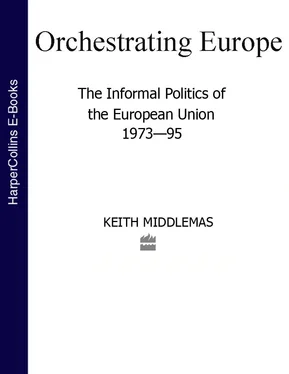1 ...8 9 10 12 13 14 ...56 By December 1947 the first feasibility study for the Franco-Italian Customs Union was ready. It was surprisingly optimistic and a second commission was established to investigate how it could be implemented. In March 1949, Sforza and Schuman signed a treaty that would effectuate a customs union in a number of stages. A tariff union was already envisaged for 1950 and full economic union about six years later, but through fear of Italian competition, in particular in agriculture, the French Conseil Economique (a tripartite advisory body representing labour, industry and agriculture) thrice rejected the treaty. The government drew the inevitable conclusion and demurred from presenting it to parliament for ratification. 16
It was whilst the issue of the Franco-Italian customs union was still alive that the French economy was confronted by a highly localized but serious problem; a balance-of-payments deficit with Belgium. From such unpromising beginnings was born FRITALUX, the name given to the grouping of France, Italy and the Benelux. The French solution to this trade imbalance had been a devaluation against the Belgian franc, with all the help from the Belgians in managing these ‘broken exchange rates’ that this move implied. From there the idea developed to a ‘mini payments union’ with a flexible exchange rate mechanism. Thinking in this direction was reinforced by the prospect that US dollars would be available to sponsor regional integration initiatives, which served to lubricate the discussions long after the exchange rate realignments of September 1949 had resolved France’s original problems. Given the advanced stage that the talks between France, Italy and Belgium had reached and the implications all of this would have had for Benelux, it is amazing that it was only in September 1949 that the Dutch were actually informed of what had been happening. They immediately declared that they disliked the idea and would only consider it if it were supplemented by a customs union, which would also embrace the newly sovereign West German state. The French, whilst not rejecting the idea out of hand, argued that the union would better be created first and that Germany could join later. The Dutch feared this would never materialize and that entry, if it were ever agreed, would be surrounded by so many exemptions and escape clauses that Germany might not be willing, or even able, to join. There the negotiations stuck until the spring of 1950, when it became clear that the Americans had decided to do something else with their cash – provide the initial capital for the EPU. 17
With the exception of the Benelux itself, the episodes discussed in this section all ended in failure. Yet they reveal several imperatives guiding policy in the immediate post-War period. The first was the motivation in all the modernization programs to utilize the breathing space created by Allied control over the post-War German recovery, to supplant the German position in both domestic and in foreign markets. The second was the fear of unrestricted German competition. Towards the end of 1949, Allied controls were already being relaxed; yet the powers of the new supervisory authorities were ill-defined and as yet untested. With or without the complication of the Dutch insistence on surrendering frontier controls against Germany, which a customs union would imply, the re-emergence of German industry was already a certainty. It was upon meeting that challenge, either politically or economically, that the entire commercial future of Europe depended.
The coal and steel sectors of western Europe took time to recover from the War. These key industries figured prominently in governmental recovery programs, such as the Monnet Plan in France. It was not accidental that the first major broad-based plan to integrate a specific industrial sector was the European Coal and Steel Community (ECSC). Coal and steel were important traded goods and essential industrial resources. Since they were largely similar products, they were easy to control and had a long history of being subjects of international cooperation. However, neither the timing nor the authorship of the first proposals for integration was accidental. The French initiative stemmed from an acceptance that this plan would, realistically, be their only method of establishing any control over German re-industrialization. French plans for the reconstruction of their steel industry had been based on an attempt to secure markets which had previously been German and also upon guaranteed access to German coal supplies. In 1950, the US policy of relaxing controls threatened to release excess German steel capacity upon a market that was already showing signs of becoming glutted. If, at the same time, German coal was redirected towards German mills, and coal supplies to France were priced relatively unfavourably, the adverse effects on France would be compounded. The Benelux countries, and to a lesser extent Italy, were pulled into the arrangements because they could not afford to remain aloof from a powerful producer bloc being created on their borders.
The Schuman Plan, as it was known, had been prepared in the French Planning Commission by Jean Monnet’s staff. It was launched on 9 May 1950, on the eve of talks with the Americans and the British on future controls of the Ruhr’s industry, and was clearly aimed at seizing the policy agenda. The British had been neither consulted nor informed of the proposals beforehand, but quickly ascertained that the organizational form implied too great a surrender of sovereignty, and that they required an entanglement in continental Europe of a nature that was inconsistent with their other foreign obligations. French attempts to persuade them to participate, the sincerity of which has been questioned, were quickly abandoned and, in the summer of 1950, negotiations began. The treaty of Paris, establishing the European Coal and Steel Community, was signed in March 1951 and came into effect in July 1952. 18
The stated goal of the treaty was to rationalize the production and sale of coal and steel. To this end, all import and export duties, subsidies and other discriminatory measures on the trade of coal and steel were immediately abolished. Although rules for pricing were established, in ‘normal’ circumstances the market was supposed to be competitive. The Community also managed funds for subsidizing firms hurt by the creation of the ECSC and for retraining workers. These were aimed particularly at the Belgian coal industry, some sectors of which were penalized by a combination of thin seams and high labour costs. Over a transitional period, efficient producers paid a levy to enable Belgian mines to adjust to the lower prices. Moreover, because of the heavy weight of fixed costs, the industry was extremely vulnerable to fluctuations in demand and therefore many of the remaining provisions were intended to come into effect in ‘abnormal’ circumstances; namely, to mitigate the impact of price falls in times of recession. It is curious that although cartel practices were prohibited within the community, the ECSC’s marketing policy in the rest of the world was identical to those that would have been followed by a private cartel.
The innovation in the treaty, and the reason why it inspired such interest among proponents of deeper ‘integration’, lay not in the settlement of a potential political and commercial problem but in the manner of its resolution. The ECSC was administered by an organizational structure which bore many outward similarities to that of the future EEC. It was controlled by the High Authority (HA), a supranational organization comprised of nine independent members assigned by each of the participating nations, which was free to initiate reaction where it had competence and rights to do so at extremes of the business cycle.
The HA co-operated with a Consultative Committee recruited from producer, labour, consumer and distributive interests. It also worked closely with a Special Council of Ministers, in which each country would have one vote, whose role was designed to increase as decisions on coal and steel impinged on wider economic and security issues. The HA was ultimately responsible to the Common Assembly comprising 78 members drawn from national parliaments. Although the HA was the most powerful governing body, the Council could block certain decisions and the Assembly could force the resignation of HA members. 19
Читать дальше









![Brian Thompson - A Monkey Among Crocodiles - The Life, Loves and Lawsuits of Mrs Georgina Weldon – a disastrous Victorian [Text only]](/books/704922/brian-thompson-a-monkey-among-crocodiles-the-life-thumb.webp)


